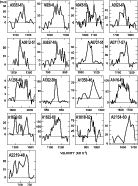A couple of years ago Karachentseva & Karachentsev (1998; hereafter KK98) initiated an all-sky search for candidates for new nearby dwarf galaxies using the second Palomar Sky Survey and the ESO/SERC plates of the southern sky. The results of the first two segments of the survey have been published, they cover large areas around the known galaxy groups in the Local Volume (KK98) and the area of the Local Void (Karachentseva et al. 1999). In a next step to derive distances we will measure radial velocities. Later on we will aim for more exact photometric distances. In this paper we present the first follow-up observations, the HI search for the galaxies in KK98. The HI search for dwarf irregular galaxies seems quite efficient as these galaxies are HI rich in general and with adequate velocity resolution, say 5 kms-1, all the HI of a given galaxy will be within a few velocity channels. The characteristic signature of a dwarf galaxy profile, a nearly gaussian structure, is different from radio interference and easily will lead to a good signal-to-noise ratio.
 |
Figure 2:
HI profiles observed with the Nançay radio telescope (HPBW of
|
 |
Figure 3:
HI profiles observed with the Australia
Telescope Compact Array. The synthesized antenna beam is of the order
of 1
|
Copyright The European Southern Observatory (ESO)